By SONG Jianlan (Staff Reporter)
To tackle poverty and inequality toward attaining two of the 17 sustainable development goals set by UN, representatives of academies of sciences under the umbrella of the InterAcademy Partnership (IAP) convened in Beijing to work out potential solutions, with support of natural and social sciences.
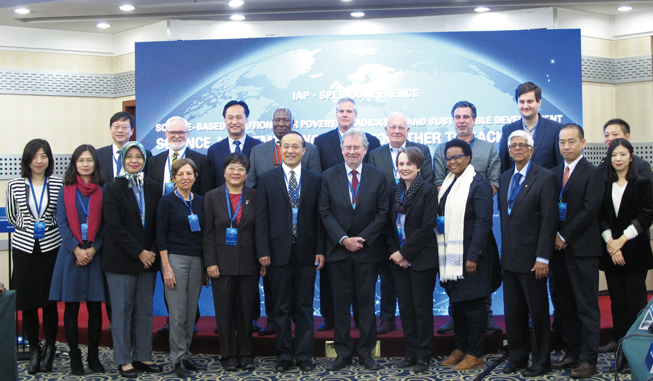
Prof. ZHANG Tao, CAS Vice President (sixth from left, front row) and Prof. Luiz Davidovich, President of the Brazilian Academy of Sciences (sixth from right, front row) pose with the participants. (Photo by SONG Jianlan)
“Today about one fifth of the world’s population are still living in extreme poverty, in need of the most basic resources,” said Prof. ZHANG Tao, Vice President of the Chinese Academy of Sciences (CAS), when addressing the opening of a meeting occurring on Dec 9 and 10 in Beijing to explore science-based solutions for eradication of poverty and reduction of inequality. “Therefore, we believe that in this area, of a global scope, transdisciplinary cooperation is very imperative,” he continued, when explaining the goal of the meeting.
“The Chinese government has placed great importance on poverty eradication,” ZHANG further emphasized, citing the implementation of the policy termed “targeted poverty alleviation” over the past five years in China. On average, this move has liberated 13 million people a year from poverty since its implementation. He also gave a brief introduction to the progress of poverty reduction in the country via S&T support and technology transfer.
ZHANG’s initiative for enhanced cooperation was echoed by Prof. Luiz Davidovich, President of Brazilian Academy of Sciences (BAS). “In the dimension of the whole humankind, we are facing many global challenges, which are affecting all the countries… Among them are food security, natural disasters, climate change, water management, and health,” he said. “Science has a very vital role to play in tackling all these challenges,” further he asserted.
SDGs: Common Challenges
Under the theme “Science-Based Solutions for Poverty Eradication and Sustainable Development: Science Academies Working together to Tackle SDGs,” the meeting joined together experts in both natural and social sciences to work out potential comprehensive solutions for poverty eradication and inequality reduction. The two issues respectively address the first (no poverty) and the 10th (reduced inequality) of the 17 sustainable development goals (SDGs) to be attained by 2030, as set by the United Nations (UN) at the 2015 UN General Assembly. To meet these ambitious goals, the global academia has risen to tackle some common challenges, like climate change, food security, natural disasters, and environment protection, to achieve shared development and prosperity. The meeting represents an effort made by the Science for Poverty Eradication Committee (SPEC) under the InterAcademy Partnership (IAP), a global partnership of over 130 Academies of sciences, engineering and medicine, of which CAS is a member.
Sponsored by CAS and IAP-SPEC, the conference was organized by the Institutes of Science and Development, CAS (CASISD), a top think-tank under CAS devoted to policy and strategic research for issues of national importance that require participation from scientific communities.
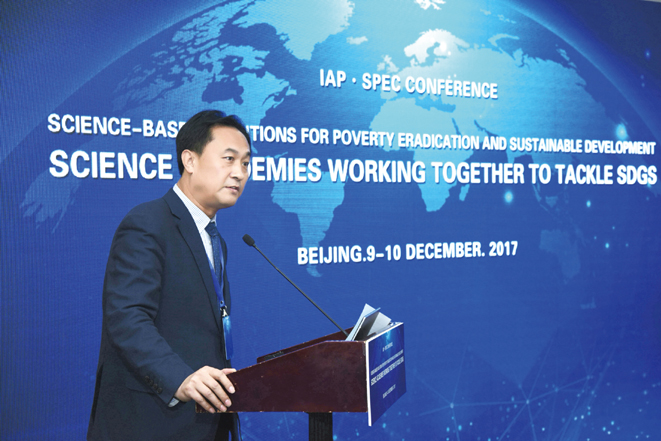
Prof. LIU Yansui, Director of the Research Centre for Regional Agriculture and Rural Development (RARD), also Director of the CAS Center for Assessment and Research on Targeted Poverty Alleviation, gives a lecture on targeted poverty alleviation in China. (Photo by courtesy of CASISD)
The whole meeting was arranged into five sessions of panel discussions, respectively focusing on five specific issues, namely: 1) Developing new programs and identifying best policies and strategies to end poverty; 2) Implementing social protection systems and measures covering the poor and the vulnerable; 3) Organizing and mobilizing society and resources towards the ending of poverty; 4) Fostering equal opportunities and developing programs to empower the poor; and 5) Improving scientific input to promote human development. The discussion of each session, lasting for 30 minutes, was informed by two 20-minute lectures given by experts from different countries and research areas. From the discussion emerged some discourses that might have mirrored the intense interest and concerns of the IAP members.
Targeted Poverty Alleviation
The first four sessions of panel discussions each had one key lecture given by a Chinese expert, sharing experience of poverty reduction and sustainable development of China from different perspectives. The first one, given by Prof. LIU Yansui, Director of the Research Centre for Regional Agriculture and Rural Development (RARD), also Director of the Center for Assessment and Research on Targeted Poverty Alleviation, CAS, attracted great attention and keen interest from participants.
LIU has spent two decades doing research on poverty alleviation in rural China. His lecture focused on targeted poverty alleviation, which represents the most recent strategy and efforts of China to end poverty via science support. LIU first reviewed the early history of poverty reduction against the context of the country’s development, and the proposal of the concept “targeted poverty alleviation” by the State leadership several years ago. “In general,” he summed: “the pathway started from helping the poor with acquiring adequate food and clothes, evolved to reducing poverty of certain regions as a whole, and further, gradually transformed to sophisticatedly refined targets.” This evolutional path, he concluded, is well aligned with different phases of the country’s overall development, as well as the practical demands of its poor communities.
The hard core of the concept “targeted poverty alleviation,” he introduced, lies in solving the real problems of poverty, and really reducing poverty. More accurately, it targets precisely identified objectives, precisely arranged projects, precisely allocated funds, and precisely implemented policies and personnel assignment, to make sure receiving the expected effects. The targeted effects feature reduced poverty resulting from different measures. These measures, each addressing different situations, could involve developing the indigenous productivity; relocating people from ecologically fragile regions to those of better natural resources; ecological compensation system for natural reserve residents; enhanced education; and social protection system, particularly for the elderly who have lost their working ability.
In the remaining part of his lecture, LIU briefed on the major goals and challenges of poverty reduction in China.
The year 2020 marks an important deadline for China’s ambitious move to end poverty and build up a well-off society. By then, China is to have eradicated poverty in its countryside. This goal, introduced LIU, encompasses three layers of sub-goals: first, to end poverty (in the sense of its current definition) in the rural population; second, to help the 832 most impoverished counties in the country (labeled with “key counties covered by the national poverty reduction program”) develop their economies, and hence lifting them out of poverty; and the third, to solve the problem of overall poverty at a regional level.
To meet this grand goal, CAS has carried out three major tasks, introduced LIU: providing the third-party evaluation for the effectiveness of targeted poverty alleviation, providing science support as a national think-tank; and building platforms for domestic and international academic exchanges, including exchanges in technology and policy research.
The efforts made by the whole society, including CAS and other forces from Chinese academic circles, have seen encouraging effects, introduced LIU.
“In 1978, as many as 250 million people in our population were stricken by poverty. In 2012, this number was slashed to less than 100 million; and by the end of last year it was further reduced to only 43 million, seeing another big drop,” he demonstrated with statistics the spiraling reduction of poverty in China, in an optimistic tone. The occurring rate of poverty dropped from 30.5% of 1978 to 10.2% in 2012, and further to 4.5% in 2016, he continued. “The rate of this year, which is coming out soon by the end of 2017, is expected to be below 4%,” he added. Changes were also visible in terms of infrastructure improvement in the countryside, as well as reduction in number of impoverished counties, LIU said.
Despite the achievements, LIU cautioned, China is facing great challenges to further implement the policy of targeted poverty alleviation. Prominent among them is the imbalanced distribution of natural resources and imbalanced economic development – the vast west of China is deeply stricken by poverty, and how to accurately target efforts and resources to such areas and solve their real problems are the most important and difficult. Other adversities, including the complexity of poverty-causing mechanisms, and the lack of inherent endogenous momenta to drive the local economic development, are also calling for more sophisticatedly refined solutions. Potential solutions, he continued, could emerge from institutional innovation, enhanced leadership, improved science support, and pooling forces and resources of the whole society to tackle such challenges. Particularly, the roles of S&T innovation and scientists shall be given a full play. “Hopefully what we have learned could shed some light on the global efforts to end poverty,” he concluded.
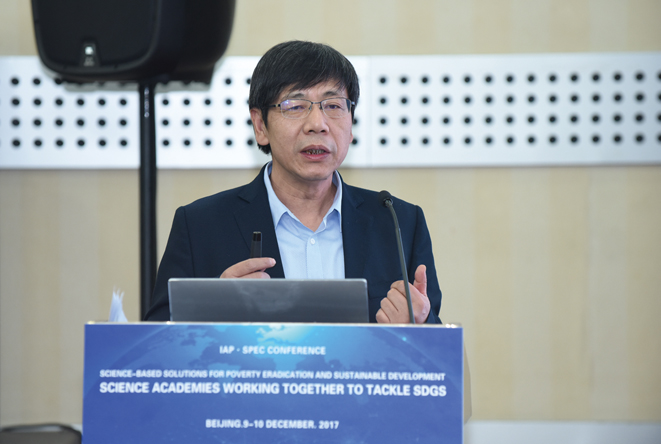
WU Guobao, a researcher from the Chinese Academy of Social Sciences, introduces the universal efforts of poverty alleviation in China pooling resources from all sectors of society. (Photo by courtesy of CASISD)
Experience from China in poverty reduction, commented Prof. Julian May, Director of NRF-DST Centre of Excellence in Food Safety, University of the West Cape, South Africa, might offered a reference for other countries, for example, Africa. “Many people on this continent are still in extreme poverty, whilst China resolved this problem several decades ago,” he particularly mentioned.
LIU and his Chinese peers, however, seemed to be more cautious about administering Chinese prescription to other countries and areas.
“It is necessary to mention that it might be difficult to directly copy experience acquired in China for other countries,” commented Prof. WANG Yi, Vice President of CASISD and an expert in sustainable development policy. WANG has been delving into the field of sustainable development for 30 years. “We might rely more on political resources and the whole political system to reduce poverty; such large-scale mobilization of the whole society might be difficult to achieve for other countries. However, some individual cases might be worth sharing,” he affirmed.
Pooling Social Resources for Poverty Reduction
“China alone accounts for almost two thirds of the total reduction in the number of undernourished people in the developing regions since 1990,” says The Millennium Development Goals Report 2015 (p.21) released by UN – This might provide a footnote for the great interest shown by the participants to poverty reduction in China. Over the past decades, China has lifted about 800 million people from poverty. For many, it might be of special interest how this has happened. Prof. WU Guobao from the Chinese Academy of Social Sciences offered a more macroscopic view.
WU introduced the universal efforts of poverty alleviation in China pooling resources from all sectors of society. In China, WU explained, poverty alleviation is led and dominated by a governmental authority called Poverty Relief Office. Aside from the centralized efforts guided and arranged by this office, individuals and organizations from the wider society also contribute to this grand cause. “This mirrors the belief of the Chinese government: it deems poverty relief as a responsibility of the whole society, rather than several certain departments,” he said. “On the other hand, it embodies the philosophy of common prosperity held by the State leadership,” he reiterated.
This mode of universally socialized poverty relief, he continued, helps to pool resources from the whole society to the largest extent, to serve a common goal. “The government plays a powerful leading role in guiding, coordinating and mobilizing social resources to serve the goal of poverty reduction, and this might be worth sharing with other countries as some valuable experience,” he remarks. “Such socialized poverty relief is taken by the government as a policy device to narrow the development gap between different regions; in this system, the government cooperates with different actors from the wider society at varied levels to reduce poverty,” he advanced.
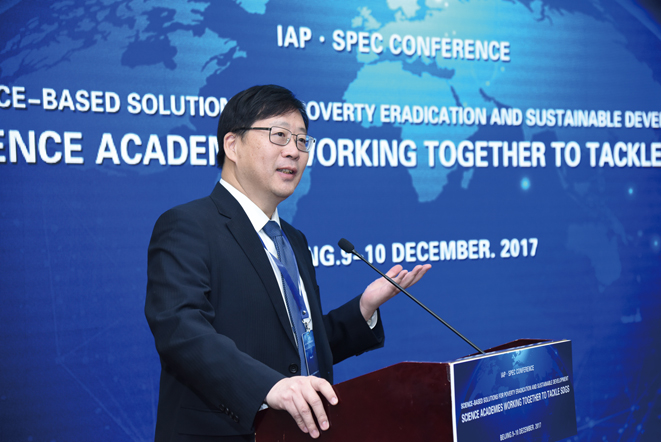
Prof. WANG Yi, Vice President of CASISD gives an overview of the pathway of China's national development, detailing the social frameworks in which sustainable development polices are implemented. Wang has been engaged in policy research for sustainable development in China for 30 years. (Photo by courtesy of CASISD)
Prof. Judith Teichman from the Department of Political Science, University of Toronto, Canada shared her insights in the role of socialized poverty reduction, from the perspective of political science. In this aspect, she insisted, science could help establish an alliance across different sectors of society to work toward the common end of poverty eradication. “Science communities can help raise the public awareness of poverty and inequality, and further arrive at a social consensus.
Participants from different countries and disciplines joined the discussion with fresh materials from their own research, providing insights in how to improve social efforts of poverty alleviation, sharing learned experiences and identifying possible solutions.
“Green is Gold”
Poverty alleviation is a goal of most priority for China’s sustainable development at the current stage. For those who are interested in the progress of poverty eradication in China, the speech given by Prof. WANG Yi, Vice President of CASISD offered a broader context of the policy landscapes.
WANG has been delved into polices of sustainable development for three decades, and has been the chief scientist of the annual Report of Sustainable Development. He sketched an overall pathway of sustainable development in China, focusing on the evolution of the dominant philosophy of development, and the emergence of the concept “ecological civilization,” with details on the social frameworks in which it is implemented, its targets, actions and challenges, and the most critical issues of its priorities.
Development of China, WANG said, represents a philosophy-led model: First a philosophy of development is proposed; aligned with this philosophy, national layout and planning are mapped out and goals defined; further, pilot and demonstration projects are conducted; and finally, the philosophy is generalized and applied to the whole country.
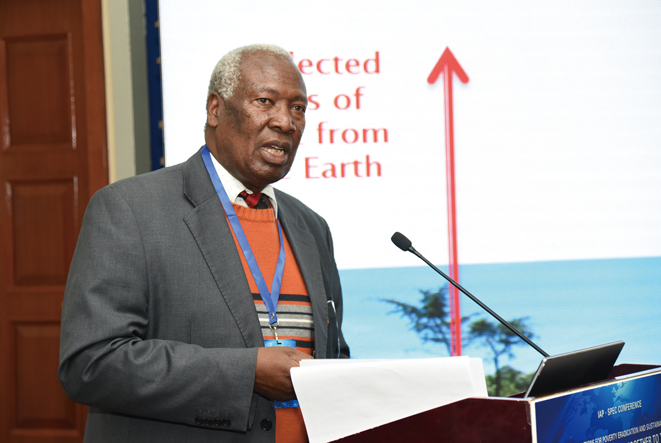
Prof. Ratemo Michieka, Honorary Secretary of Department of Crop Science, University of Nairobi, Kenya, talks about the challenges for Africa, an agriculture-dominant continent vulnerable to climate change.
“Sustainable development has become a national strategy of China since the 1990s, and now the philosophy leading the strategy is ‘ecological civilization,’” WANG continued. “This concept will dominate the long-term development of China until 2050, including the green transition of its economy, which is of great importance to China,” he emphasized.
In 1994, China released its “21st Agenda,” marking the first country in the world to practice sustainable development. The goals of this Agenda have been permeated into every sector of society, and among them, poverty relief has topped the priority. In 1996, the National Congress set sustainable development as a national strategy of the country, and now it still tops the list of the seven major national strategies of the country.
The first three decades following the implementation of the policy of “Reform and Opening-up” in the 1980s, WANG said, saw a GDP-first philosophy for development. This philosophy has helped China grow into a middle-income country – at the cost of its natural environment. Now this philosophy has been replaced by a protection-first one: “Green is Gold.” This philosophy was first proposed in 2005 by Chinese President XI Jinping, then Secretory of Zhejiang Provincial Committee of CPC, as a summary of his long-term thoughts about the country’s development mode. In 2012, the concept “ecological civilization” was formally stated as a national strategy for development.
Following this philosophy, the social, economic, cultural and political development of the country need to be aligned with the protection of the environment, and this makes necessary a transition to the green track of development.
“Therefore, we’ve arrived here, with a new set of strategies for the 2020 version of sustainable development. A central issue at the core of the strategies is how to establish a modern economic system. It must be a green, low-carbon and recycle economy, totally different from the one dominating the past 30 years,” WANG concluded.
“What we need to do now? First, we need to map out a strategy for this transition,” stated WANG. “Second, we need to propose a comprehensive package of policies; and the third, we need to identify proper ways to turn the green concept into a new dynamic, and this is the most important part of our current work,” he remarked.
“In response to this call, CAS has worked out a roadmap toward attaining the goals by 2050, predicting the future technological development in 18 areas of science and technology,” he advanced.
“All in all,” he reiterated: “despite the achievements, China is facing a lot of challenges. On the one hand, we hope to find out good solutions for our own problems; on the other, we hope to cooperate with other developing countries to attain sustainable development of the global scale.”
Enhancing the Role of Science
When exploring possible solutions for poverty eradication, Prof. Ratemo Michieka, Honorary Secretary of Department of Crop Science, University of Nairobi, Kenya, talked about the challenges for Africa, an agriculture-dominant continent vulnerable to climate change. Describing cases where science might play a positive role to help this continent fight against and adapt to climate change, for example protecting crops from infecting insects and helping them survive harsh environments, he expressed earnest expectation to interventions from scientific communities, particularly the member academies of IAP.
In response to Prof. Michieka’s presentation, Prof. Luiz Davidovich expressed his concerns about the situation in Brazil, where farmers are destroying the tropical rainforests to make a living. “Actually, the great biodiversity in these forests constitutes a precious treasure-trove,” he remarks. “The problem is, unearthing and developing these valuable resources rely on transdisciplinary cooperation,” he asserted.
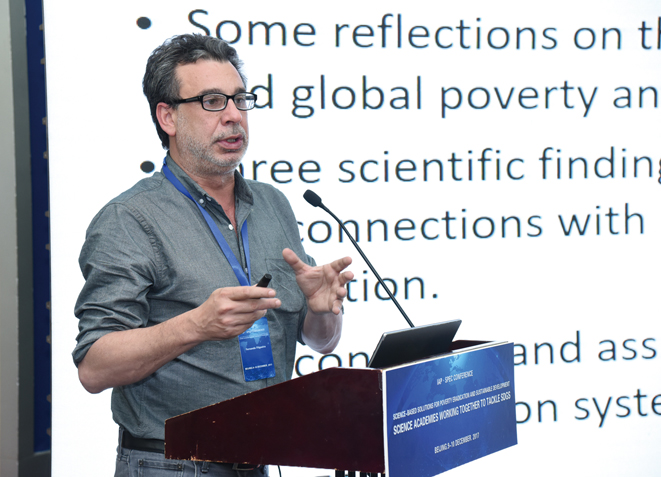
Prof. Fernando Filgueira from the Center for Information and Studies of Uruguay provides a solution for improving the social protection system prevailing the world.
“We have to explore these resources, and make full use of them. Science should offer a hand, developing biotechnology aimed at conservation of biodiversity; at the same time, we shall learn from the locals and make use of indigenous knowledge. For example, that about plants of medicinal use,” he continued.
An expert in medical science, Prof. Lai-Meng, Looi from the Department of Pathology, University of Malaya advanced to suggest that all academicians of the member academies under IAP, as well as all the member academies should play their roles in education and raise public awareness of the value of biodiversity. On the other hand, scientists shall help the local people with developing needed technologies to utilize the local resources in alignment with the goal of protecting biodiversity.
Targeting Inequality
In connection to poverty, inequality is another challenge to tackle toward attaining SDGs. At the meeting, experts examined this issue through different lenses, including improving the design of social protection system, based on evidence supported by science.
Prof. Fernando Filgueira from the Center for Information and Studies of Uruguay provided a solution for improving the social protection system prevailing the world. After a brief review of the origin of global inequality and poverty in relation with the development of international order, he challenged the presumptions underlying the current social protection system by providing scientific evidence. “These scientific discoveries are giving momentum to changes in policy, but still it is not fast enough. Our knowledge is not driving technical changes very well. We all have social protection systems in our countries; however, they are based on wrong or outdated knowledge,” he asserted.
Other participants joined in and discussed possible solutions from different perspectives. Some offered insights in promoting gender equality, and some cast their attention to the imbalance in resources allocation between the rural and the urban areas within a country.
Experts noticed the population migration from rural to urban regions and expressed their worries about this trend of centralization. People are forsaking the countryside. What can science do? What can science academies do?
Revitalizing the Countryside
According to Prof. WANG Yi, the central government of China is now formulating its strategy and policy to revitalize rural China. This is expected to bring about tremendous changes in this populous country, and might shed some light on rebalancing allocation of resources between the rural and urban world.
“I would like to propose that we set a specific goal for ending poverty and inequality, and make an action plan aiming at this goal,” suggested Prof. LIU Yansui. He initiated establishing a platform for enhanced inter-academy cooperation.
Echoing LIU’s suggestion, Prof. Luiz Davidovich suggested establishing some structural framework, under which IAP could act in collaboration with other international organizations like UNESCO.
Given the importance and complexity of poverty eradication as well as inequality reduction, the participants arrived at an initial agreement on an action plan that foresees the organization of a big international conference on these topics.
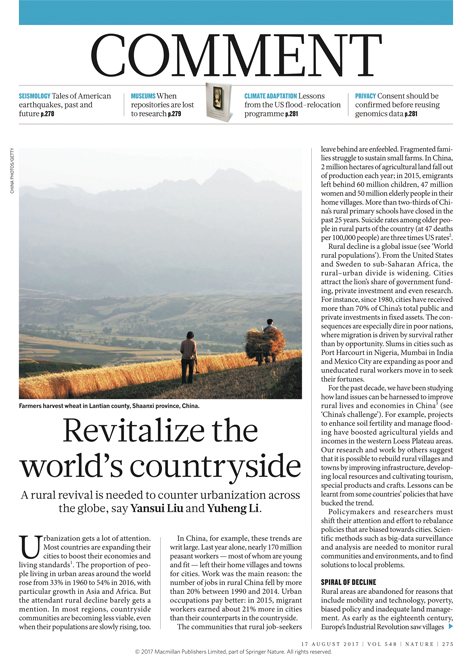
In the August 17 issue of Nature, a team of CAS scientists led by Prof. LIU Yansui, Director of the Research Centre for Regional Agriculture and Rural Development (RARD), CAS expressed their concerns about the declining countryside as a global trend, and proposed some solutions. According to WANG Yi, Vice President of the CAS Institutes of Science and Development, the Chinese central government is now formulating the strategy and policy to revitalize rural China. Tremendous changes are in view.

